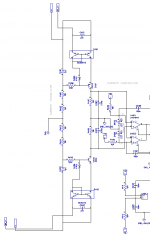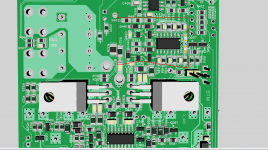Is this a trick ? loads of IRS2452 flooding the market but no stock of IRS20957STRPBF is this Infineon Technologies way to rid the market of the IRS20957STRPBF ?
Basically they are eliminating everything managable.8 Dip 16dip sop every thing. Now everything comes in a square shaped package. That sucks man.
I don't mind living without the DIP footprint, but I'm curious what the future is for the IRS20957 SOP - what is the the equivalent ?
i'm thinking about doing a single supply full bridge amp with irs2452,altough i'm not super experienced so I don't know what the end result would be,plus the chips are pretty expensive,anyone know of full bridge gate drivers with over current protection ?
I don't mind living without the DIP footprint, but I'm curious what the future is for the IRS20957 SOP - what is the the equivalent ?
Its dead end because capacitively isolated chips have taken the stage. IRS2452AM will also die in the meantime. Poor designers can't design a good pcb to control the negative transient on SW node of high side return, causes latch up in these ICs, whereas isolated chips are virtually immune and are idiot proof.
Yeah - I never really thought of things that way. Sitting with x10 IRS20957 chips that's getting a layout for a x4 channel amplifier, Shown: I have Current, Voltage and other things feeding into a external control card (not developed as yet) that will use an STM32H7 and measure across all x4 channels and do ALL things.Its dead end because capacitively isolated chips have taken the stage. IRS2452AM will also die in the meantime. Poor designers can't design a good pcb to control the negative transient on SW node of high side return, causes latch up in these ICs, whereas isolated chips are virtually immune and are idiot proof.
Recently bought 100 IRS20957 on a Mauser for 2u9 euros. This is quite a normal price. The next shipment is in half a year, sadly. We are working on stock balances.
IRS2452 is not suitable, too much dead time.
We use SI8234/44 with a small analog current control circuit. The SI8234 is available now for $3.
IRS2452 is not suitable, too much dead time.
We use SI8234/44 with a small analog current control circuit. The SI8234 is available now for $3.
Infineon's policy is very annoying, why there has been a shortage of IRS20957 chips for over a year now. To support production, they sometimes bought them for $15 a piece. it's just awful.
This is the kind of current control circuit we used. The delay is about 400ns.
This is the kind of current control circuit we used. The delay is about 400ns.
Attachments
We have many IRS20955 in stock which we purchased from IR before they were purchased by Infineon.
It is pin for pin the same as the IRS20957.
If anybody needs some we can ship world wide. at $2.50 each + freight.
Zed Audio
It is pin for pin the same as the IRS20957.
If anybody needs some we can ship world wide. at $2.50 each + freight.
Zed Audio
In the future will move to SI8234/44 and have the MCU do everything if I was crazy enough I would just build a gate driver using an FPGA/CPLD cool runner but this is overkill. I don't mind writing code on various platforms as long as they close to bare metal and obey and fast reaction ISR pattern things should be portable.Recently bought 100 IRS20957 on a Mauser for 2u9 euros. This is quite a normal price. The next shipment is in half a year, sadly. We are working on stock balances.
IRS2452 is not suitable, too much dead time.
We use SI8234/44 with a small analog current control circuit. The SI8234 is available now for $3.
Every car audio amplifier manufacturer is sitting/demanding IRS20957 stock probably. Also, I have qty x20 SI8233BB' but this is of no use as it doesn't contain the inverter.
Last edited:
Infineon's policy is very annoying, why there has been a shortage of IRS20957 chips for over a year now. To support production, they sometimes bought them for $15 a piece. it's just awful.
This is the kind of current control circuit we used. The delay is about 400ns.
You could remove this comparator setup and have your MCU perform protection evaluation with much more flexibility, replace the red boundary with a TL074 and have the x2 OPAMPs act as a buffer/ gain adjustment/firewall and have the MCU ADC deal with the OC trip points. You may need to write fast code that deals with non-fractional numbers for the fastest reaction speed.
Thank you, of course. However, try running such a circuit in practice first, with the controller 15mm away from the output stage. There are some hidden difficulties here 😉
I think the only workable option is to use an analogue comparator in the microcontroller, but in my case I need two of them. And there's only one in the controller.
I think the only workable option is to use an analogue comparator in the microcontroller, but in my case I need two of them. And there's only one in the controller.
- Home
- Amplifiers
- Class D
- No stock of IRS20957STRPBF but loads of IRS2452

